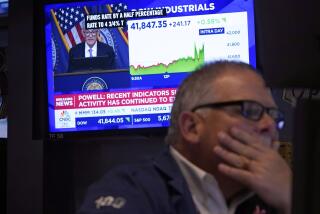Two Key Rates Cut Cautiously by Bundesbank : Germany: Critics say reductions are not deep enough to begin reviving Europeâs stagnant economies.
BONN â In a long-awaited relaxation of monetary policy, cautious central bankers cut Germanyâs leading interest rates Thursday by half a percentage point, but critics said the reduction is not deep enough to begin reviving Europeâs moribund economies.
The Bundesbank reduced the discount rate, the cheapest rate on loans to commercial banks, to 6.25% from 6.75%; it cut the Lombard rate, the rate on emergency loans to banks unable to find money elsewhere, to 7.25% from 7.75%.
It was the first easing of the two key rates since July, when the central bankâs refusal to dramatically cut the cost of funds thrust Europe into a monetary crisis.
âThis has to be welcomed, but in no way does it invoke an interest-rate-reduction bonanza that many European economies need,â said George Magnus, chief international economist for S.G. Warburg Securities in London.
Actions by the independent central bank in Frankfurt are closely watched throughout the world because of the dominant role the German economy and currency play in Europe.
Many analysts believe lower interest rates would help revive the German economy, encourage similar rate cuts in other countries and promote growth and new jobs. Officials in the United States believe lower rates would help American companies and workers by creating more demand for exports.
But the Bundesbank--chronically fearful of inflation and the heavy burden of government borrowing to finance German unification--has moved slowly. In a brief statement Thursday, the bank said the lowered rates represent âa continuation of its policy of cautious interest rate cuts.â
It said it is comfortable lowering rates now in part because of recent signs âof a gradual easing of price increases.â German inflation has remained relatively steady at 4.2%.
Last month, the German bankâs refusal to rush into rate cuts caused the virtual collapse of the European monetary system, the primary mechanism linking European currency exchange rates.
Thursdayâs cuts, however, prompted some of Germanyâs partners to trim their interest rates. Cuts were announced by central banks in France, Italy, Belgium and Austria.
But analysts said bigger reductions are needed.
âIt is simply not enough,â said Gustav Horn, an economist with the German Institute of Economic Research in Berlin. âAt this pace, it will take until the middle of next year before we reach the needed levels.â
In Brussels, Henning Christophersen, the European Communityâs commissioner for economic affairs, described the reductions as âa ray of sun at a time of uncertainty,â but said more cuts are needed. âIt is a decision that has to be followed by a general reduction in interest rates to create more growth and employment,â he said.
The Bundesbankâs announcement was praised by the German government, which has long seen lower interest rates as essential for the countryâs economic recovery. Statistics released this week indicated that the moribund German economy showed new life for the first time in 15 months, but government officials warned that even so, all is not well.
German Finance Minister Theo Waigel said Thursday that lower interest rates combined with a strict program to cut government spending would help pull Germany out of its worst recession since World War II.
âWith this decision, the Bundesbank is supporting efforts to restore the economic growth within and outside Germany,â he said.
Oskar Lafontaine, economics spokesman for the opposition Social Democratic Party, said the rate cuts were long overdue.
He also warned that Germanyâs export-dependent economy can no longer cope with an overvalued currency.
Normally, lower German interest rates would send other currencies soaring against the German mark, making German exports more attractive. But with the small cuts Thursday, the mark actually strengthened against some currencies, including the dollar.
âThis is exactly what we do not want,â economist Horn said. âThe international market was looking for a steeper reduction.â
The cautious easing of the two rates continued a yearlong Bundesbank policy that has seen rates drop only gradually and in small increments. Last September, the discount rate peaked at 9.75% and the Lombard rate at 8.75%. Since then, there have been seven reductions.
More to Read
Sign up for Essential California
The most important California stories and recommendations in your inbox every morning.
You may occasionally receive promotional content from the Los Angeles Times.










